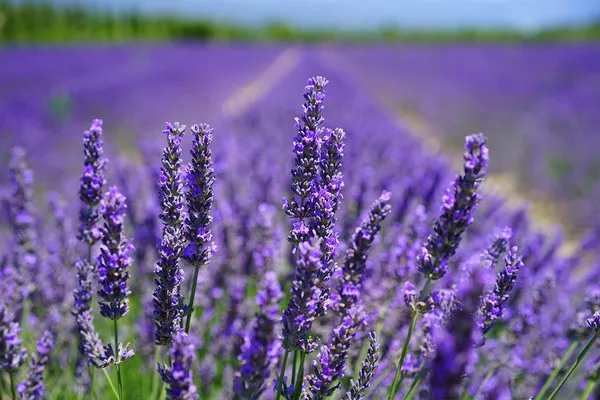In the vast realm of floral diversity, few colors captivate the human imagination as much as purple. Symbolizing royalty, spirituality, and enchantment, purple flowers have a unique allure that has fascinated people for centuries. In this article, we will explore the most popular purple flowers, their meanings, significance in various cultures, and how they contribute to our aesthetic and emotional well-being.
SEE ALSO: Enigmatic Beauty: 4 Kinds of the World’s Rarest Blue Flower
The Allure of Purple Flowers
1. The Color Psychology of Purple
Purple is a color that evokes a sense of mystery, elegance, and creativity. It lies at the intersection of calming blue and passionate red, making it a symbol of balance and harmony. Psychologically, purple has been associated with spirituality, transformation, and introspection. As a result, purple flowers are often seen as more than just decorative elements; they carry profound emotional and symbolic meanings.
2. The Language of Flowers
Throughout history, flowers have been used to convey emotions and messages through a symbolic language known as “floriography.” Purple flowers, in particular, were often given to express admiration, adoration, or to communicate a sense of enchantment. They are frequently chosen for special occasions like weddings, anniversaries, and to honor loved ones.
3. Cultural Significance
Purple flowers hold unique cultural significance in various societies. In ancient times, purple was a rare and expensive dye, making it reserved for royalty and nobility. As a result, purple flowers became associated with regal qualities and were often used in royal ceremonies. In some cultures, purple flowers are also connected to spirituality and religious practices, signifying devotion and reverence.
The Most Popular Purple Flowers
1. Lavender (Lavandula spp.)
Lavender, with its delicate spikes of purple blooms and soothing fragrance, is one of the most beloved purple flowers worldwide. Its name is derived from the Latin word “lavare,” meaning “to wash,” highlighting its historical use in baths and perfumes. Lavender’s calming properties make it a popular choice in aromatherapy, and it is often associated with relaxation and tranquility.
2. Purple Tulips (Tulipa spp.)
Tulips come in various colors, including enchanting shades of purple. Purple tulips symbolize royalty and admiration, making them an excellent choice for conveying respect and appreciation to loved ones. These stunning flowers are widely cultivated in gardens and are highly sought after for their elegance and grace.
3. Purple Roses (Rosa spp.)
Roses are the epitome of love and beauty, and when they bloom in shades of purple, their allure intensifies. Purple roses represent enchantment, love at first sight, and even the mystical and magical. They are often used in romantic gestures and celebrations of deep affection.
4. Purple Orchids (Orchidaceae family)
Orchids are known for their exquisite beauty and diverse colors, including shades of purple. Purple orchids are a symbol of luxury, refinement, and rare beauty. They have a unique and alluring appearance, making them highly coveted for ornamental purposes.
5. Purple Hyacinths (Hyacinthus spp.)
Hyacinths, with their dense clusters of fragrant blooms, come in several colors, including shades of purple. These flowers symbolize playfulness and joy, bringing a sense of cheerfulness to any setting. Purple hyacinths are often used to express sincerity and deep emotions.
6. Purple Irises (Iris spp.)
The regal and elegant appearance of purple irises makes them stand out in any garden or floral arrangement. Purple irises symbolize wisdom, hope, and valor. They are associated with the Greek goddess Iris, who was considered a messenger between heaven and earth.
SEE ALSO: Iris Flowers: How Long Bloom & Blooming Cycle
7. Purple Lilacs (Syringa vulgaris)
Lilacs, known for their captivating fragrance and clusters of dainty blossoms, are popular in shades of purple. Purple lilacs symbolize the first emotions of love and youthful innocence. Their sweet scent and beautiful appearance make them a cherished addition to gardens and bouquets.
SEE ALSO: Lilac Flowers: Exploring the Beauty& Versatility
The Healing Power of Purple Flowers
Beyond their aesthetic appeal and cultural symbolism, purple flowers have been linked to various healing and therapeutic properties:
1. Aromatherapy: The calming and soothing fragrance of lavender and other purple flowers is widely used in aromatherapy to alleviate stress, anxiety, and promote relaxation.
2. Herbal Remedies: Some purple flowers, like violets and lavender, have been used in traditional herbal medicine for their potential health benefits.
3. Mood Enhancement: The sight of vibrant purple blooms can uplift spirits and enhance mood, offering a sense of joy and positivity.
4. Meditation and Spirituality: In spiritual practices, purple flowers may be used as a focal point for meditation or to create sacred spaces.
Conclusion
Purple flowers hold a special place in the hearts of people across cultures and time. Their enchanting beauty, rich symbolism, and healing properties contribute to their popularity in various aspects of human life. Whether it’s the serene lavender fields, the captivating allure of purple roses, or the elegance of purple irises, these blossoms continue to inspire and bring joy to our lives, reminding us of the profound connection between nature and human emotions.


